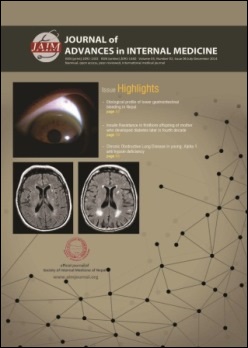Etiological profile, gender difference and age group patterns of 415 patients presenting with lower gastrointestinal bleeding in the western region of Nepal
DOI:
https://doi.org/10.3126/jaim.v3i2.14064Keywords:
Etiology, gender, lower gastrointestinal bleeding, colonoscopy, NepalAbstract
Background: Lower gastrointestinal bleeding (LGIB) is a common clinical condition associated with significant morbidity and mortality. The aims of our study were to determine the etiological profile, gender difference and age group patterns of LGIB in Nepal.
Methods: A total of 415 consecutive patients presenting with LGIB from April 2011 to September 2014 underwent colonoscopy and the etiology of LGIB was determined. Each diagnosis was compared with respect to the gender and age group.
Results: Among 415 LGIB patients (males 62.2%, females 37.8%), the different etiologies of LGIB were as following: hemorrhoid 35.2%, non-specific colitis 24.8%, colon polyp 18.3%, inflammatory bowel disease (IBD) 10.4%, colon cancer 6.5%, diverticulosis 1.7%, unknown 1.4%, upper gastrointestinal bleeding 1.2% and radiation colitis 0.5%. The overall LGIB was more common in male; however, colon polyps were diagnosed more commonly in female (p<0.001). Among LGIB patients, the hemorrhoid was more common in the age group of 30-49 years, colon polyp in 50-69 years, colon cancer in 70-84 years, and non-specific colitis and IBD in 16-29 years (p<0.001).
Conclusion: Hemorrhoid and non-specific colitis were the common causes of LGIB in Nepal; colon polyp, IBD and colon cancer were the next common causes. More males presented with LGIB than females; however, colon polyp was diagnosed more in females, which needs to be explored further. When LGIB was presented after 50 years of age, the most likely causes were colon polyp and colon cancer; hence colonoscopy is recommended in all LGIB patients after 50 years.
Journal of Advances in Internal Medicine 2014;3(2):52-55
Downloads
Downloads
Published
How to Cite
Issue
Section
License
This license enables reusers to distribute, remix, adapt, and build upon the material in any medium or format, so long as attribution is given to the creator.




